
|
November 2012
|
|
|
The U.S. Department of Energy's Thomas Jefferson National Accelerator Facility
|
|
Jefferson Lab Appoints its First
|
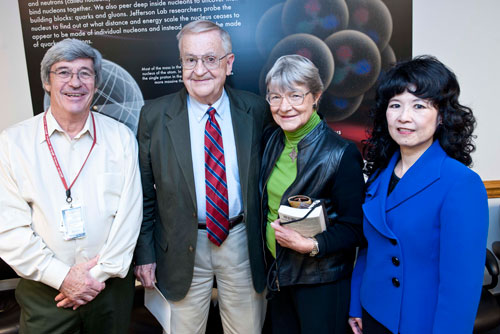
Jefferson Lab Director Hugh Montgomery (left to right), newly appointed JSA Scientist Emeritus Dirk Walecka, Kay Walecka and Elizabeth Lawson, representing SURA/JSA, pause for a photo after Montgomery announced Walecka's appointment as scientist emeritus.
Jefferson Lab researchers and administrators gathered on Nov. 12 to recognize J. Dirk Walecka, the lab's first scientific director, for his crucial contribution to the founding and development of Jefferson Lab and for his ongoing support of the lab. Lab Director Hugh Montgomery began the presentation to honor Walecka, with the observation: "When a lab is young it doesn't often spend time thinking about what it is doing – its history and the people who are critical to making that history happen. When a laboratory becomes older and wiser it starts to think about those things. And it is the result of one of these thought processes that brings us here today." "It was with this thinking in mind that Jefferson Lab approached JSA regarding instituting a (formalized) JSA Scientist Emeritus program," he continued........ more |
|
|
JSA Awards $412K for FY13 Initiatives Fund Program
|
Alston Wins National American Welding Society Award
|
With Cryo Group, NASA Space Chamber Reaches Unprecedented Efficiency
|
||
|
|
||||
Below the Fold: |
||||
Jefferson Lab Appoints its First
|
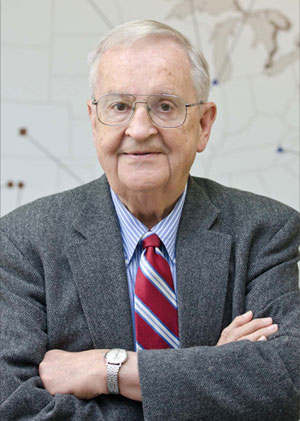
Dirk Walecka
JSA Scientist Emeritus Jefferson Lab researchers and administrators gathered on Nov. 12 to recognize J. Dirk Walecka, the lab's first scientific director, for his crucial contribution to the founding and development of Jefferson Lab and for his ongoing support of the lab. Lab Director Hugh Montgomery began the presentation to honor Walecka, with the observation: "When a lab is young it doesn't often spend time thinking about what it is doing – its history and the people who are critical to making that history happen. When a laboratory becomes older and wiser it starts to think about those things. And it is the result of one of these thought processes that brings us here today." "It was with this thinking in mind that Jefferson Lab approached JSA regarding instituting a (formalized) JSA Scientist Emeritus program," he continued. "An emeritus appointment is to do honor to the recipient, and today we recognize the achievements of Dirk Walecka with the honorific of Scientist Emeritus. And it is with great pleasure that I ask Dirk to accept this appointment." The Jefferson Lab Emeritus Program is outlined on the lab's Human Resources webpage. It is open to retiring or retired scientists, engineers, and technologists who have demonstrated leadership and contributed to the goals of the lab during a productive career. Other factors that may be considered include: years of service, professional accomplishments and recognition by the national and international community as evidenced by honors and awards received by the individual. The title of JSA Scientist Emeritus, JSA Engineer Emeritus, or JSA Technologist Emeritus may be bestowed and granted for a five-year term, with renewable one-year terms available. Biographical Sketch of John Dirk Walecka
J. Dirk Walecka received his B.A. degree summa cum laude from Harvard in 1954 and his Ph.D. degree from MIT in 1958. He was a National Science Foundation Postdoctoral Fellow at CERN and at Stanford before he joined the Stanford University faculty in 1960. He became a full professor at Stanford in 1966; and held an A.P. Sloan Foundation Fellowship at Stanford and at CERN from 1962-66. He was chair of the Stanford physics department from 1977-82, and has been a professor emeritus at Stanford since 1987. In 1986, Walecka became Scientific Director of CEBAF and served in that capacity until 1992, when he became the Governor's Distinguished CEBAF Professor of Physics at the College of William and Mary and a Senior Fellow at CEBAF. He was chair of the William and Mary physics department from 1994-2000. Walecka was elected a Fellow of the American Physical Society in 1971, and has served on the APS executive committee and chaired the Division of Nuclear Physics. In 1970, Walecka received the Gores Award for Excellence in Teaching from Stanford and in 1991 was the Distinguished Schiff Lecturer there. He won the Division of Nuclear Physics Tom W. Bonner Prize in 1996 and received the Eugene Feenberg Medal in 2009. He was named the recipient of the Commonwealth of Virginia's Life Achievement in Science award in 2003. Then Gov. Mark Warner described Walecka as "one of the world's leaders in nuclear theory." He has authored more than 130 scientific publications including several books. In addition to his many scientific achievements, Walecka has educated, trained and mentored dozens of young nuclear physicists. Array of Contemporary American Physicists: J. Dirk Walecka http://www.aip.org/history/acap/biographies/bio.jsp?waleckaj An emeritus staff member will have access to lab office space and computing facilities, and may be returned to service to assist with a specific task in a part- or full-time capacity as approved by the lab director. "At a lab there is sometimes the opportunity to stay on beyond one's retirement and possibly do something special, and this program will provide for these opportunities," Montgomery said. Walecka was one of the founders of CEBAF/Jefferson Lab. "Many consider his move from Stanford (University) seminal to the creation of the lab," Montgomery noted. "At the lab's 25th Anniversary, Secretary (of Energy) Steven Chu extolled Dirk's achievements." After accolades from Montgomery and Michael Pennington, associate director for Theoretical and Computational Physics, Walecka addressed the group: "I wish to thank Mont and Michael and each of you for this gracious gesture. I'm proud of what this facility has done in the past, what you are doing today, and what it will do in the future," Walecka said. "It is gratifying to see the reach and impact of Jefferson Lab research," he continued. "One-third of the Ph.D.s in nuclear physics in the U.S. have done research based on work conducted at Jefferson Lab. I am proud and gratified by that. Bright, talented, creative young people are this country's most valuable resource. As our recently re-elected President has repeatedly stated: 'Education and research are a top priority.'" After the presentation, Pennington presented Kay, Walecka's wife of 58 years, with a framed portrait of Walecka, and announced that a portrait of him has been installed on the theoretical and computational physics corridor – joining those of Jefferson Lab's chief scientists. (After his term as the scientific director, the position became the lab's chief scientist post). Walecka is currently a Governor's Distinguished CEBAF Professor of Physics, Emeritus, at the College of William and Mary. |
JSA Awards $412K for FY13 Initiatives Fund Program |
|
Jefferson Sciences Associates announced in a Nov. 27 news release the award of $412,000 to support projects related to education, outreach and career development to staff and users at Jefferson Lab. Since 2006, JSA, which operates and manages Jefferson Lab for the Department of Energy, has provided over $3 million to support 140 projects under its JSA Initiatives Fund Program. The Initiatives Fund supports programs, initiatives and activities that further the scientific outreach, and promote the science, education and technology missions of Jefferson Lab in ways that complement its basic and applied research focus. The program is managed and administered by the Southeastern Universities Research Association, a consortium of more than 60 leading universities, for the JSA Programs Committee. SURA and the Applied Technology Division of Computer Sciences Corporation jointly own JSA. "Over the years, these diverse projects and initiatives have added value to Jefferson Lab's programs and helped to cultivate the support of the science and user communities," said Hugh Montgomery, JSA president and Jefferson Lab director. The fiscal year 2013 Initiatives Fund Program includes new awards for 29 projects. More than 45 percent of the award funds support the education and outreach programs at Jefferson Lab. The remaining awards support postdoctoral career development, other lab programs, Jefferson Lab users initiatives and activities, and several topical science meetings. A complete listing of the FY13 awards can be found at: http://www.jsallc.org/IF/IFProjects.html. The 2013 evaluation committee was chaired by Elizabeth Beise from the University of Maryland. Other committee members included JSA Programs Committee Chair June Matthews from MIT, David Armstrong from the College of William and Mary, William Briscoe from The George Washington University, Paul Eugenio from Florida State University, Daniel Sober from The Catholic University of America, Robert McKeown representing Jefferson Lab, and Elizabeth Lawson, representing SURA/JSA. "One of the important features of the Initiatives Fund Program is that its funds are often matched with other source funding. This year, more than $400,000 in matching and contributing funds have been committed to the new awards, making it possible to stretch Initiatives Fund dollars to support more proposals," said Beise, while also commending the JSA owners for their continued support of the program. SURA President and CEO Jerry Draayer and CSC/ATD Vice President and General Manager Paul Branske noted that the investment in the Initiatives Fund Program enables Jefferson Lab and its users to engage more effectively in many educational, scientific, technical, and outreach activities that contribute to the lab's overall ability to accomplish its mission. More than 1,300 scientists from around the world use the lab's unique particle accelerator to conduct experiments to expand our understanding of the matter that makes up the visible universe. The complete release is posted at: http://www.jsallc.org/news/JSAIF20121127.pdf. |
J. Alston Wins National-Level American Welding Society Award |
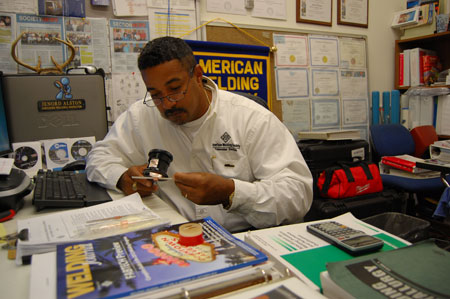
Jenord Alston, welding process expert, at work in his office in the Machine Shop.
As a child growing up in Newport News, Jenord Alston watched his uncles welding out in the backyard. He was mesmerized by the intensity of the process and the results of their efforts. For a youngster, it looked like magic. The experience made him eager to learn about welding. And the course of his life was set. That's how it was and still is for Alston, the Jefferson Lab Machine Shop's welding process expert. "Welding is fire, it's control, it's artistic, it's science," he said recently, with a passion that burns intensely even after three decades. That passion and his extensive of knowledge and skill have taken him to the top of his field. Alston received the Dalton E. Hamilton Certified Welding Inspector Award from the American Welding Society earlier this month. The association calls the award "the Super Bowl ring of welding inspection, the grail sought by those who don't just want to excel… they hunger to dominate." Alston was presented with the award at the group's annual meeting in Las Vegas, Nevada, Nov. 12-14. The binder for his award nomination is a tome – literally – a full five inches thick, page after page enumerating and documenting his career in the field of welding. But he's quick to give credit for the award to everyone around him. "Everybody throughout the lab plays a role in the science we do here," he pointed out. "Even though the award will have my name on it, it truly belongs to everyone here. I've been supported by the lab from the very beginning. I think of this award as the lab's return on its investment in me." By the time he started taking welding classes in high school, Alston already knew the art. After high school, he went to work first at the Newport News shipyard and others along the East Coast, then for several years at power plants all over the country. Where some people may take a dismissive view of the field, Alston began every day asking: "What will they let me weld today?" And it didn't matter what the answer was. Alston took to every job with a perfectionist's heart: "There was no difference in what I was working on," he said. "The attention I gave to welding on a Navy ship was the same level of attention that I gave to welding on a dumpster." As a member of the AWS for more than 20 years, and the current chairman of the Tidewater Section, Alston has been an active participant in the group. He also volunteers his time with area colleges and high schools where he sits on their welding advisory boards, and speaks to and mentors youths who are interested in the craft. He presents quarterly student award winners at New Horizons with prizes he purchases himself; and he serves as a judge for the Virginia Skills USA district and state welding contest. Alston, whose reputation in the local welding community is well known, was invited to join the Jefferson Lab team in 2001, first as a contract staff member before becoming a regular employee six years ago. When the Department of Energy directed standards for welding practices at its labs, Alston stepped quite naturally into his current position as the lab's welding process control specialist. He received his national inspection certification after passing the grueling six-hour test; and Will Oren, head of the Engineering Division, asked him how the lab could use his new qualification. Now, he spends about 60 percent of his time on "paper work," helping with required welding-related documentation and meeting with the engineers and designers at the outset of their projects. "It's always best when they involve me from the beginning," he said. "I believe it's better to be a problem preventer than a problem solver. If a project gets past a certain point without my involvement, it becomes much more difficult to deal with a problem that could have been prevented." He acknowledged that, early on, some engineers were reluctant to involve him. "I knew I had to earn their trust, and I believe I did," he said. "Now, they're at my door, and I welcome that. I think they are starting to view me as a resource for them." Alston hasn't lost his touch for hands-on work, though. He trains welders and works with them on passing their welding test. He and wife, Joyce, who's a cosmetology instructor, have two grown children and two grandchildren. They met in middle school and married right out of high school. "She understands the passion I have for the welding industry better than anyone else. She's been there for the entire journey and I'm thankful for that." The toy ATV on his desk is a reminder of the real one he enjoys riding at home. In his spare time, Alston also enjoys hunting – deer and turkey – with both a bow and arrow or a gun. "When I'm out in the woods, the concerns of the job just wash away from me," he noted. "Then when it's time to come back, I'm refreshed and ready to go." While Alston is excited about bringing the American Welding Society award to the lab, he's not about to rest on his laurels. "I still have a lot of time left in my career at JLab, so there's no time for relaxing. There's always room for improvements." He considers the honor the high point of his vocation. "No matter how far I go in my career, I'll always consider myself a welder and, hopefully, other welders will be inspired to set their standards and goals high as well." By Judi Tull |
With Cryo Group at the Helm, NASA Space Chamber Reaches Target at Unprecedented Efficiency |
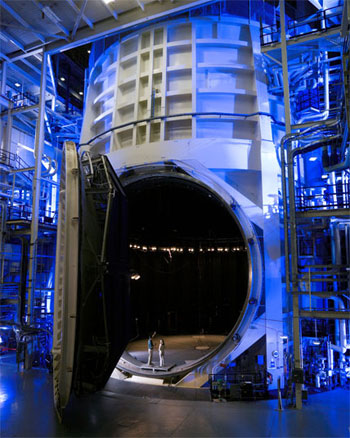
NASA Johnson Space Center's Space Environment Simulation Lab Chamber A. Photo: NASA
As the U.S. sweated through its warmest summer on record outside, a testing chamber at NASA Johnson Space Center in Houston reached its coldest temperatures yet on the inside, cooled by one of the world's most efficient cryogenic refrigeration systems. Designed by members of Jefferson Lab's Cryogenics group, the system reached its target temperature of 20 Kelvin, about -424 degrees F, for the first time in May and again during commissioning tests in late August. It reached its target temperature in just over a day and maintains a steady temperature with less than a tenth of a degree in variation over a load temperature range of 16 to 330 Kelvin, all with no loss of helium and using half the liquid nitrogen than comparable systems. But what is even more remarkable is its ability to maintain design efficiency down to a third of its maximum load. "The range of load temperature and capacity while maintaining peak efficiency and temperature stability is unprecedented," said Venkatarao (Rao) Ganni, deputy Cryogenics Department head, and a key member of the system design team. The successful cool down is great news for NASA, which will be using the Space Environment Simulation Lab Chamber A to subject components of the James Webb Space Telescope to the rugged conditions it will encounter in space when it is launched in 2018. Jonathan Homan, a senior engineer in the Systems Test Branch of the Thermal Systems Division at Johnson Space Center, is in charge of the cryogenics operations of Chamber A. "The satellite is going to orbit the sun away from the Earth at a point called L2, it's about a million miles away from the Earth, about four times the distance of the moon," Homan explained. "All flight hardware needs to go through a very rigorous test and integration program. The satellite has to be exposed to the environment it's going to be living in for the next decade or so. The only way to verify its proper operation is to get the optics to the on orbit temperatures and test their functionality. This way, the program can verify that the scientists get the data that they are looking for." The Upgrade Challenge 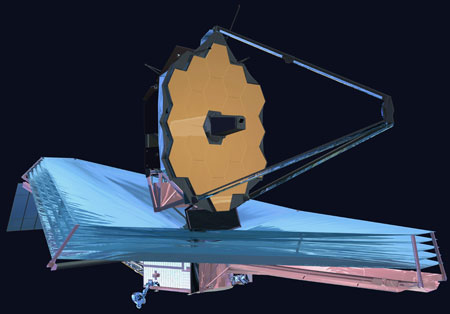
An artist's rendering of the James Webb Space Telescope. Image: NASA
Chamber A was chosen to test the integrated primary optics of the James Webb Space Telescope. The chamber was built in the 1960s to test the Apollo Service and Command module to simulate the space conditions in a near-Earth orbit, and its trip to and from the moon. Chamber A already had its own cryogenics systems to create this environment. A liquid nitrogen system was capable of cooling the chamber to 80-90 Kelvin to re-create the bleak cold of space. The chamber also had a liquid helium system, which was used to create a space-like vacuum by 'cryopumping', or condensing, air from the chamber. "Chamber A was designed originally to test the Apollo Service and Command module back in the Apollo program era, and of course, it's been used for the space station and Sky Lab, and many other NASA and non-NASA space projects that need a large, thermal vacuum facility," Homan said. One big problem faced by NASA, however, was upgrading the separate cryogenics systems to meet the new demands that would be placed on the testing chamber by the ambitious James Webb Space Telescope. As it stood, the chamber's cryogenics systems were not capable of meeting the basic requirements of the tests. First, the range of refrigeration had to be extended from 80 Kelvin down to at least 20 K. Next, the tests needed to be conducted over long durations, 90-120 days, which was not possible due to system components (pumps) that required maintenance every two weeks, and a great number of valves, with each one a potential point of failure during a test. And finally, the system was inefficient, gobbling up 48,000 gallons of liquid nitrogen every day to maintain consistent operations. Adding to the difficulties, large-scale cryogenics systems are usually designed for a specific function, with no two exactly alike. Making an upgrade even more of a challenge, the NASA team wanted very much to re-use components that they already had onsite to reduce the cost and installation time. To meet these goals, the decision was made to approach cryogenics experts in industry and at national labs to find the best solution. "We haven't been able to find in industry that link between people who own and operate equipment and people who design and build equipment, and that's really what I was able to find with the Cryogenics group at Jefferson Lab. You've got a group there that not only understands the operations, but also the detailed design on the equipment that they are operating and maintaining," Homan said. Ganni agreed and explained that the members of the lab's Cryogenics group has that knowledge through their own experience in industry, as well as through involvement in the building, operating and/or improving the cryogenics plants at Jefferson Lab, Brookhaven National Lab, Oak Ridge National Lab and others. "At the beginning of my career, I worked for industry, and I was involved in the design of cryo plants. In industry, people would give us their specifications, and we really don't have a complete picture of its end use, except for these few descriptions. We would have a really short duration to understand what the customers really needed," Ganni explained. "As a user, I have a much more clear understanding of the experiment's cryogenic needs. So, when I came to JLab, I realized that we know more about what we want and can write these in the specifications to the vendor. So we should separate what they are good at and we should do our own work, because we are competent enough to do that work ourselves." It was this experience and willingness to pioneer new technologies that led the group to improve the efficiencies of the laboratories' cryogenics systems, applying the concepts of the patented Floating Pressure - Ganni Cycle and other improvements to reduce the cost and improve the efficiency and stability of cryogenics operations. In the early stages of the Chamber A project, the group applied the Floating Pressure - Ganni Cycle to an existing industry-supplied refrigerator, dramatically improving its reliability and its efficiency and temperature stability by an order of magnitude. A New System 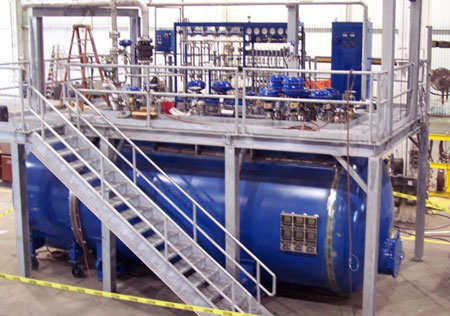
The cold box under construction for the new 20 Kelvin helium refrigerator at NASA Johnson Space Center's Space Environment Simulation Lab Chamber A.
Initially, the JLab Cryo group was requested by NASA to provide the process design and from that develop the specification for the helium refrigeration system that will allow the chamber to reach 20 Kelvin. This new helium system is similar to an air conditioning system that circulates its working fluid (i.e., the refrigerant), absorbing heat from one location (the place being cooled) and rejecting it to another (usually the ambient environment). However, that is where the similarity ends. It operates on a different thermo-dynamic cycle and uses much larger and a different type of compressor and heat exchanger. Also, unlike an air conditioner, it uses a turbine expander that operates at thousands of revolutions per second. This new helium system was designed to operate using the Floating Pressure - Ganni Cycle. A few years into the project, NASA also requested the Cryogenics group's help in the design modifications of the chamber's liquid nitrogen system that is needed to provide a thermal intercept temperature between the 20 Kelvin helium and ambient temperature. The system previously used by NASA circulated the 80-90 Kelvin liquid nitrogen using pumps and many valves and components. This type of system is known in the field as a forced-flow design. The Cryogenics group's proposal was to convert the liquid nitrogen system to a gravity-fed design, also called a thermo-siphon, which works in roughly the same way as an old-fashioned percolator coffee maker. A smaller scale thermo-siphon design had been installed and successfully used for Jefferson Lab's 2 Kelvin cold box located at the CHL. However, one had never before been incorporated into an upgrade of such a large facility. Chamber A is mammoth, having a hinged door over 12 meters in diameter, a height of over 36 meters, and a diameter of almost 20 meters. After thermal and process modeling of the proposed thermo-siphon proved favorable, NASA chose to include it in the final design, ultimately reducing the system installation cost, improving reliability, reducing operation and maintenance costs, and consuming less liquid nitrogen. Other improvements included far fewer valves, better-insulated piping and a drain that allows the return of the remaining liquid nitrogen (not used during testing) to the storage tanks for future use. "Everything in the plant was designed and specified by JLab: the process, the components and everything being built." Ganni said. The group has found that this greatly assists the vendors seeking to provide the equipment and provides the most effective trade-off between equipment performance and cost. All contracts were competitively bid by NASA. The helium cold box was awarded to Linde Kryotechnik AG, the helium compressor skids to Salof Refrigeration and the gas management and oil removal equipment to a Hampton Roads company, Riggins Company. Tests a Success The cooldown was expected to take about 48 hours. Instead, it was complete in the first attempt in just 30 hours. As the system was pushed to its limits, it demonstrated its ability to provide 11.2 kW at 15 K, all the way to 118 kW at 100 K, holding the temperature steady to within plus or minus 0.1 K. So, it not only exceeded its design load, but it exceeded its design temperature range and temperature stability. In fact, the system is far more flexible than any ever built. It is capable of maintaining a steady temperature at any figure between 15 and 330 K, a hugely impressive range. "Space simulation testing definitely requires extreme temperature swings, both at cryogenic and hot temperatures," Ganni said. In addition, due to the Floating Pressure - Ganni Cycle, it was able to maintain its peak efficiency down to one-third of its maximum capacity. 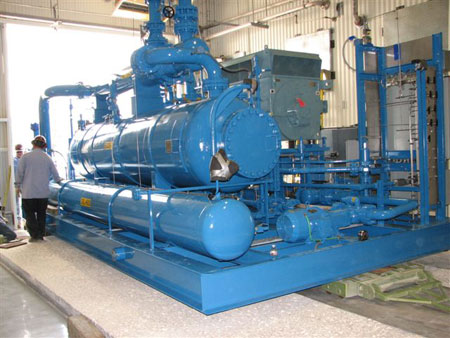
A compressor being installed for the new 20 Kelvin helium refrigerator at NASA Johnson Space Center's Space Environment Simulation Lab Chamber A. The new system will allow testing of components of the James Webb Space Telescope.
"Our system automatically matches to the need of the load." Ganni explained. "The key is automatic. No one else needs to take it there; the system says okay, this is the load it needs, and I am going to figure out how to satisfy that, and at the most efficient way. That's what the whole floating pressure theory is all about." In addition to the success of the helium refrigerator, the liquid nitrogen thermo-siphon cooling system was also successful. It requires a mere 18,000 gallons to cool the chamber, compared to the old figure of 58,000 gallons. What's more, due to the efficiencies introduced by the thermo siphon, the system used just 24,000 gallons of nitrogen each day in operations, compared to the 48,000 that would have been used without it. It also drained the unused liquid to the storage tanks at the end of the test, allowing the door and scavenger panel to operate independently, cooled by the liquid (while the other panels were warmed-up), allowing the chamber to achieve a bake-out temperature of 70 degrees Celsius. Now, as other upgrades to the chamber continue, plans are being made to use the chamber to conduct operational tests of components of the James Webb Space Telescope. Beyond NASA The Central Helium Liquefier-2 is being built to support the cryogenics requirements of the CEBAF accelerator operating at 12 GeV. Ganni said that the project benefitted from the NASA work, in that it provided a template for the group's procurements for CHL-2. "How are the specifications going to be, how is it going to be procured, how is it going to be installed, it's already been worked through the system." Ganni added, so the group didn't have to reinvent the wheel. Once that upgrade is complete, there's more work to do. The Facility for Rare Isotope Beams will need a cryo plant. And they know just who has the expertise to design it. By Kandice Carter Relate Links: |
JLab's Founding Director Honored with Prestigious Slack Award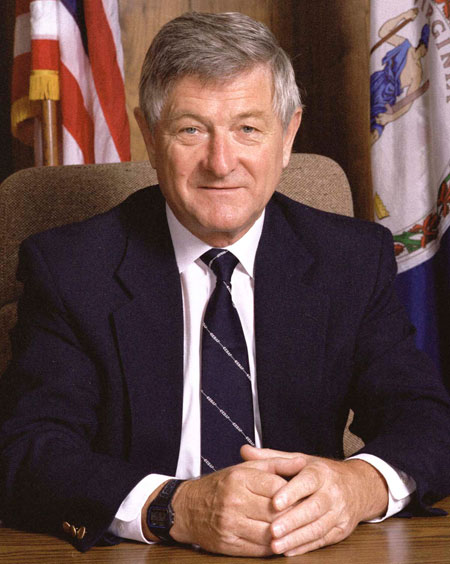
Hermann Grunder, the founding director (1985-2000) of Jefferson Lab, received the Francis G. Slack Award by the Southeastern Section of the American Physical Society on Nov. 16.
Hermann Grunder, founding director of Jefferson Lab, was recently awarded a Francis G. Slack Award by the Southeastern Section of the American Physical Society in recognition of his outstanding career and contributions to physics. Grunder, who served as director of Jefferson Lab from 1985 to 2000, received the award on Nov. 16 during the 79th annual meeting of the American Physical Society's Southeastern Section in Tallahassee, Fla. Grunder was the deputy director of the Lawrence Berkeley Laboratory in California when he was recruited to lead the design, construction and operation of Jefferson Lab, then known as the Continuous Electron Beam Accelerator Facility. As the lab's first director, he commissioned an internal review of the design plans and brought forward a recommendation that the accelerator be based on superconducting radiofrequency technology – the first major research institution fully dependent on SRF technology in the U.S. It was a bold move that he promoted beyond DOE to the Office of Science & Technology Policy (OSTP) and the Office of Management & Budget (OMB). In the end, the decision to deploy superconducting technology proved to be a brilliant success, paving the way for other large-scale installations around the world to use the technology. As director, Grunder also launched faculty joint appointments and bridge appointments at Jefferson Lab. "These have served as model initiatives for many other facilities. Since the establishment of these programs through Hermann's tenure, over 70 new faculty lines have been added in nuclear physics in the Southeast," according to Jerry P. Draayer, president and CEO of the Southeastern Universities Research Association, (SURA) who nominated Grunder for the award. Draayer received the Slack Award in 2006. After Jefferson Lab, Grunder served as director of Argonne National Laboratory from 2000 to 2005. Born in Basel, Switzerland, Grunder received his mechanical engineering degree from the University of Karlsruhe (Germany) and his Ph.D. in experimental nuclear physics from the University of Basel. He started his U.S. physics career at Lawrence Berkeley Lab in 1968. The Southeastern Section is the largest regional section in the APS. Francis G. Slack was a distinguished Vanderbilt University scientist and a charter member of the Southeastern Section of APS. The award in his name was established in 2000 to recognize those who have worked unselfishly to: (1) bring about significant new research facilities in the region; (2) significantly strengthen and raise the stature of particular departments of physics in the region; (3) provide significant leadership and work to strengthen and build the Section and other physics societies and regional organizations; (4) develop physics consortia of universities and/or research institutions that have benefited the region and the nation; and, (5) carry out other service and administrative activities such as organizing major conferences held in the region, international exchanges, and public outreach to K-12. Editor's note: This news brief is from the SURA press release at: http://sura.org/news/2012/SlackAwardGruunder111912.pdf. 'Tis the Season for eCard Scams The holidays are here again, and with them come the yearly flood of electronic greeting card scams. As popular as eCards are with your family and friends, they're even more popular with Internet fraudsters. Being aware and following safe practices can help individuals from learning this, firsthand. "There is email out there spreading links to sites which, if visited using a browser, could infect your computer," he points out. "Usually they don't wipe out your computer now-a-days, but use it to spread more spam and steal your personal information. And that can have longer lasting consequences than ruining your hard drive." The e-thieves' biggest targets are credit card numbers, bank account details and other information that could help them steal both your identity and your money. Worse, the eCards themselves can appear to come from legitimate sites or to have been sent by your actual friends and relatives. Telling the legitimate eCards apart from the scams can be very difficult, and guessing incorrectly can cause real problems. So what can you do to help protect yourself (and Jefferson Lab) from this type of attack? Here are some tips: * The most effective thing is to ignore the eCard altogether. If you don't click that link or open that attachment, the scam will fail. When you receive one of these electronic cards (and odds are that you will), ask yourself, "Does this look suspicious in any way?" If so, simply delete the message and bask in the knowledge that you've helped maintain the lab's cybersecurity and protected your personal information. If you'd like to do some additional reading on eCard scams, here are several good URLs to start with: If you have questions, contact the IT Division Help Desk at helpdesk@jlab.org. Jefferson Lab Activities Group Announces Holiday Events, Activities JLab Children Invited to Children’s Holiday Party Santa Claus plans to drop by with JAG Dog Training Club member, Dan Young, Physics Division, and his two Samoyeds, Nikko and Tally, for photographs with the children. Youngsters may take part in games and craft activities. Light snacks and drinks will be provided. All children must be accompanied by an adult. Volunteers Needed to Help With Children’s Party  Toys For Tots Toy Drive Underway As in years' past, the lab is participating in the U.S. Marine Corps' annual Toys For Tots toy drive. Bring in your donation of new, unopened toys for children ages 1-12 and deposit them in the marked collection boxes. The deadline for bringing in donations is noon Saturday, Dec. 8. Local Marines will pick up the toys at the Children's Party and distribute them to children in need. Marked drop boxes will be available from Nov. 28 – Dec. 7 near the main entrances of CEBAF Center, Bldg.89, SSC, ARC and TED Buildings. For more information about the Toys for Tots program, visit: www.toysfortots.org. Ready, Set, Hang Those Decorations  JAG is also sponsoring a Holiday Office Door/Cubicle Decorating Contest. Prizes will be awarded for the Best Decorated, Most Original Decoration, and the Silliest. All employees, users and contractors with an office or cubicle at JLab may enter the contest (individuals and groups). To enter, you must email JAG Chair Bridget Paul at bpaul@jlab.org by 5 p.m. Dec. 14. Include your name(s), building number and office/cube location. Judging will take place Dec. 17 and 18. Winning entries will be announced Wednesday, Dec. 19. Decorations may go up as early as Dec. 3 and should be taken down by Jan. 4, 2013. Decorating materials should be fire resistant and only UL-approved lighting/electronics may be used. Don’t use opened food items in your decorations. For instance, wrapped candy canes are ok; unwrapped cookies are not. "The holidays will be here in the blink of an eye. Plan on being part of the fun and festivities," urges JAG Chair Bridget Paul. "Mark your calendars. Look for the JAG fliers in your work areas, visit our webpage or contact a JAG committee member for more information. Please bring in a Toys For Tots donation or support a charity of your choice to help those in our community who are having a difficult time." For more information, contact JAG at jag@jlab.org or visit: https://www.jlab.org/jag/index.php DOE Awards $130M for 66 Transformational Energy Technology ProjectsOn Nov. 28, Energy Secretary Steven Chu announced 66 cutting-edge research projects selected by the Energy Department's Advanced Research Projects Agency - Energy (ARPA-E) to receive a total of $130 million in funding through its "OPEN 2012" program. ARPA-E seeks out transformational, breakthrough technologies that show fundamental technical promise but are too early for private-sector investment. These projects have the potential to produce game-changing breakthroughs in energy technology, form the foundation for entirely new industries, and have large commercial impacts. The selected projects encompass 11 technology areas in 24 states, and support the Obama Administration's all-of-the-above approach to addressing the nation's most pressing energy challenges. "With ARPA-E and all of the Department of Energy's research and development efforts, we are determined to attract the best and brightest minds at our country's top universities, labs and businesses to help solve the energy challenges of this generation," said Secretary Chu. "The 66 projects selected represent the true mission of ARPA-E: swinging for the fences and trying to hit home runs to support development of the most innovative technologies and change what's possible for America's energy future." The OPEN 2012 projects will focus on a wide array of technologies, including advanced fuels, advanced vehicle design and materials, building efficiency, carbon capture, grid modernization, renewable power, and energy storage. The projects were selected through a merit-based process from thousands of concept papers and hundreds of full applications. The projects are based in 24 states, with approximately 47 percent of the projects led by universities, 29 percent by small businesses, 15 percent by large businesses, 7.5 percent by national labs, and 1.5 percent by non-profits. ARPA-E's first funding opportunity, "OPEN 2009," was issued three years ago and was similarly an open call to America's top scientists and engineers for transformational energy technology solutions. ARPA-E's previously selected projects have already made major progress, by demonstrating the world's first 400 Wh/kg lithium-ion battery poised to revolutionize the electric vehicle industry; building a wind turbine, inspired by the design of jet engines, that could deliver 300 percent more power than existing turbines of the same size and cost; and engineering a high power laser drilling system that can penetrate hard rock formations over long distances and is ten times more economical than conventional drilling technologies.
The full DOE news release is posted at: Milestones for October 2012Hello Jennifer Allen; Staff Administrator; Environmental, Safety, Health and Quality Division Goodbye Henry Adams, Facilities Management and Logistics These Milestone entries, listed alphabetically, are full-time, term, casual and student actions posted by Human Resources for October 2012. Jefferson Lab is currently seeking qualified individuals for more than a dozen scientific, engineering and technical and intern positions. All current employment opportunities are posted at: [Link Removed] = Information about career opportunities at Jefferson Lab is available at: [Link Removed] . |
|
The On Target newsletter is published monthly by the Thomas Jefferson National Accelerator Facility (Jefferson Lab), a nuclear physics research laboratory in Newport News, Virginia, operated by Jefferson Science Associates, LLC, for the U.S. Department of Energy's Office of Science. Possible news items and ideas for future stories may be emailed to jlabinfo@jlab.org, or sent to the Jefferson Lab Public Affairs Office, Suite 15, 12000 Jefferson Avenue, Newport News, VA 23606
|


 Jefferson Sciences Associates announced in a Nov. 27 news release the award of $412,000 to support projects related to education, outreach and career development.......
Jefferson Sciences Associates announced in a Nov. 27 news release the award of $412,000 to support projects related to education, outreach and career development....... As a child growing up in Newport News, Jenord Alston watched his uncles welding out in the backyard. He was mesmerized by the intensity of the process and the results of their efforts.......
As a child growing up in Newport News, Jenord Alston watched his uncles welding out in the backyard. He was mesmerized by the intensity of the process and the results of their efforts....... As the U.S. sweated through its warmest summer on record outside, a testing chamber at NASA Johnson Space Center........
As the U.S. sweated through its warmest summer on record outside, a testing chamber at NASA Johnson Space Center........